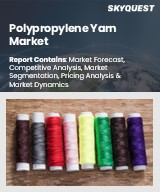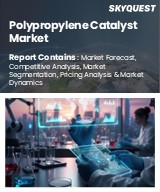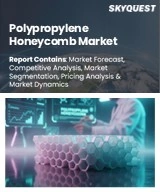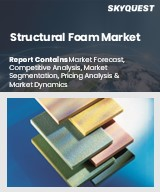
|
시장보고서
상품코드
1647407
폴리프로필렌 시장 평가 : 유형별, 용도별, 최종사용자 산업별, 지역별, 기회 및 예측(2018-2032년)Polypropylene Market Assessment, By Type, By Application, By End-user Industry, By Region, Opportunities and Forecast, 2018-2032F |
||||||
세계의 폴리프로필렌 시장은 2025-2032년의 예측 기간 중 CAGR 5.16%를 기록하며, 2024년 1,254억 달러에서 2032년에는 1,875억 7,000만 달러로 성장할 것으로 예측됩니다.
이 시장은 자동차, 포장, 섬유, 소비재 등 다양한 산업에서 다양한 용도로 사용되면서 과거에 괄목할 만한 성장을 이루었습니다. 폴리프로필렌(PP)은 화학적 영향에 대한 우수한 내성으로 인해 세계에서 가장 많이 사용되는 열가소성 폴리머 중 하나입니다.
자동차 분야에서 PP의 사용량 증가는 PP의 우수한 특성과 경량 소재로의 전환이라는 업계 동향에 기인합니다. PP는 내충격성, 열 안정성, 내습성으로 잘 알려져 있으며, 범퍼, 인테리어 트림, 보닛 부품과 같은 자동차 부품에 이상적인 소재입니다. 본질적으로 가볍기 때문에 자동차 제조업체는 연비를 개선하고 배기가스를 줄이기 위해 무게 효율을 높이고 배출가스를 줄이는 것이 필수적입니다.
국제자동차산업협회(OICA)에 따르면 2023년 세계 자동차 생산량은 6,800만대로 2022년보다 11% 증가하여 급증할 것으로 예상됩니다. 또한 식품 및 식품 및 음료을 중심으로 여러 분야에서 연포장 솔루션에 대한 수요가 증가하고 있는 것도 PP 시장 확대에 큰 영향을 미치고 있으며, PP는 가볍고 강도가 높으며 내습성이 뛰어나 제품의 유통기한을 연장하는 보호 지향적 포장 솔루션에 적합합니다. 보호 지향적 포장 솔루션입니다. 편의성과 지속가능한 포장에 대한 소비자의 요구와 함께 제조업체는 동일한 목적을 위해 PP를 사용하고 있습니다.
목차
제1장 프로젝트 범위와 정의
제2장 조사 방법
제3장 개요
제4장 고객의 소리
- 응답자 인구통계
- 구입 결정시 고려되는 요소
- 기계적 및 화학적 성질
- 유형
- 응모 요건
- 가격
- 공급업체 평판
- 애프터 세일즈 지원
제5장 세계의 폴리프로필렌 시장 전망, 2018-2032년
- 시장 규모 분석과 예측
- 금액별
- 수량별
- 시장 점유율 분석과 예측
- 유형별
- 폴리프로필렌 호모폴리머
- 폴리프로필렌 랜덤 공중합체
- 폴리프로필렌 내충격성 공중합체
- 용도별
- 사출성형
- 섬유와 라피아
- 필름과 시트
- 기타
- 최종사용자 산업별
- 패키지
- 자동차
- 건축·건설
- 소비재
- 전기·전자
- 기타
- 지역별
- 북미
- 유럽
- 아시아태평양
- 남미
- 중동 및 아프리카
- 기업별 시장 점유율 분석(상위 5사 및 기타 - 금액별, 2024년)
- 유형별
- 시장 맵 분석, 2024년
- 유형별
- 용도별
- 최종사용자 산업별
- 지역별
제6장 북미의 폴리프로필렌 시장 전망, 2018-2032년
- 시장 규모 분석과 예측
- 금액별
- 수량별
- 시장 점유율 분석과 예측
- 유형별
- 용도별
- 최종사용자 산업별
- 국가별 점유율
- 국가별 시장 평가
- 미국의 폴리프로필렌 시장 전망,2018-2032년
- 시장 규모 분석과 예측
- 시장 점유율 분석과 예측
- 유형별
- 용도별
- 최종사용자 산업별
- 캐나다
- 멕시코
- 미국의 폴리프로필렌 시장 전망,2018-2032년
모든 부문은 대상이 되는 모든 지역과 국가에서 제공됩니다.
제7장 유럽의 폴리프로필렌 시장 전망, 2018-2032년
- 독일
- 프랑스
- 이탈리아
- 영국
- 러시아
- 네덜란드
- 스페인
- 터키
- 폴란드
제8장 아시아태평양의 폴리프로필렌 시장 전망, 2018-2032년
- 인도
- 중국
- 일본
- 호주
- 베트남
- 한국
- 인도네시아
- 필리핀
제9장 남미의 폴리프로필렌 시장 전망, 2018-2032년
- 브라질
- 아르헨티나
제10장 중동 및 아프리카의 폴리프로필렌 시장 전망, 2018-2032년
- 사우디아라비아
- 아랍에미리트
- 남아프리카공화국
제11장 Porter's Five Forces 분석
제12장 PESTLE 분석
제13장 시장 역학
- 시장 성장 촉진요인
- 시장이 해결해야 할 과제
제14장 시장의 동향과 발전
제15장 사례 연구
제16장 경쟁 구도
- 시장 리더 상위 5사의 경쟁 매트릭스
- 상위 5사 기업의 SWOT 분석
- 주요 기업 상위 10사의 시장 구도
- Reliance Industries Limited
- 회사 개요
- 주요 경영진
- 제품과 서비스
- 재무 상황(보고대로)
- 주요 시장 포커스와 지역적 프레즌스
- 최근 동향/협업/ 파트너십/합병과 인수
- LyondellBasell Industries NV
- Sinopec Zhongyuan Petrochemical Co., Ltd
- Borealis AG
- Braskem SA
- Saudi Basic Industries Corporation
- INEOS Group Limited.
- Exxon Mobil Corporation
- Formosa Chemicals and Fibre Corporation
- LG Chem, Ltd.
상기 기업은 시장 점유율에 따른 순위를 보유하지 않으며, 조사 작업 중 입수 가능한 정보에 기반하여 변경될 수 있습니다.
제17장 전략적 제안
제18장 조사회사 소개·면책사항
KSA 25.02.21Global polypropylene market is projected to witness a CAGR of 5.16% during the forecast period 2025-2032, growing from USD 125.40 billion in 2024 to USD 187.57 billion in 2032.
The market has witnessed tremendous growth in the past, due to its diverse applications in a wide array of industries including automotive, packaging, textiles, consumer goods, and others. Polypropylene (PP) is one of the most used thermoplastic polymers in the world, due to its excellent resistance towards chemical implications.
The increase in PP usage in the automobile sector is substantial due to its favorable properties and the industry's current shift towards lightweight materials. PP is highly known for impact resistance, heat stability, and moisture resistance, which makes it the ideal material for some automotive parts like bumpers, interior trims, and under-the-hood parts. Since PP is inherently lightweight, it is vital for automotive manufacturers to add weight efficiency and reduce emissions to improve fuel efficiency.
According to the International Organization of Motor Vehicle Manufacturers (OICA), worldwide vehicle production surged to 68 million units in 2023, 11% more than in 2022. Furthermore, the increasing demand for flexible packaging solutions across several sectors, especially food and beverages, is a major factor adding momentum to the expansion of the PP market. PP is lightweight, strong, and moisture-resistant, making it ideal for protection-oriented packaging solutions that extend the product's shelf life. Along with consumer demands for convenience and sustainable packaging, manufacturers exploit PP for the same end.
Increasing Usage of Polypropylene-Based Materials Reduce Vehicle Weight and Enhance Fuel Economy
The prominent factors encouraging the applications of PP in the automobile market are the weight reduction of vehicles and improving their fuel efficiency, catapulting the overall growth in the global market. Auto engineers remain under pressure to enforce strict emission regulations and increase the standards of fuel economy. PP also meets such criteria as it is non-brittle and has less weight. Its application can be seen in automotive components such as dashboards, interior trims, and other structural parts.
The material is much lighter than the commonly used metallic parts, reducing the total weight of vehicles and lowering fuel consumption and emission levels. Apart from the automotive industry, the global market for electric vehicles (EV) is currently in a mobility shift, and lightweight materials, including PP, will always be important. Reducing weight enhances the battery efficiency and helps drive the demand for an EV. The growth trend in the automotive sector emerges as a leading factor driving the demand for PP in the succeeding years.
In June 2024, Borealis AG introduced glass-fiber reinforced PP with 65% PCR for demanding automotive applications. The first application was in automotive interiors in a historic project completed in collaboration with OEM Stellantis, which owns 14 automotive brands, and Plastivaloire, a thermoplastic injection specialist and Tier 1 supplier to the automotive industry.
Growing Demand for Flexible Packaging Fuel the Polypropylene Market Growth
Demand for flexible packaging solutions from the food and beverage, pharmaceutical, and consumer goods sectors drives the PP market. With excellent properties, high clarity, moisture resistance, and good sealing properties, it has become a popular material for manufacturing flexible packaging. In fact, in the recent past, the increasing demand for flexible packaging has been observed steadily. The rise in e-commerce, combined with growing concern for environmentally friendly packing material, is one of the prime drivers of this growth. PP packaging in the food and beverage industry maintains the product for longer due to its protection from moisture and contamination.
Additionally, in pharmaceuticals, PP gives sensitive drugs easy, safe, and protected packaging. Moreover, because of the shift of consumers towards environmentally friendly packaging, the recyclable ability of the polymer attracts companies seeking to lessen their ecological footprints. Moreover, expanding internet buying, along with the growing demand for packed foods, and rugged packaging are among the factors driving the demand for polypropylene in the flexible packaging market.
According to the Flexible Packaging Association, the United States sales for the flexible packaging industry were USD 41.5 billion in the year 2022. Flexible packaging forms the second largest segment after plastics packaging in the United States, accounting for about 21% of the USD 180.3 billion of the country's packaging market.
Injection Molding: the Largest Application of Polypropylene
Injection molding is the largest PP application, combining the polymer's advantageous characteristics to manufacture various products in almost all industries. These thermoplastic polymers are also valued for their low melt viscosity, allowing them to flow easily into molds, making it possible to create complex geometries and intricate designs. The injection molding process is highly efficient, capable of manufacturing thousands to millions of identical parts quickly at low production cost, especially beneficial for mass production.
In addition to these excellent properties, PP exhibits good resistance to fatigue and moisture and excellent chemical stability. It is ideal for automotive parts, consumer goods, medical devices, and packaging applications. Typical products produced via PP injection molding include food containers, automotive interior parts, and living hinges. The versatility and performance characteristics of polypropylene ensure that this material remains a preferred one in the injection molding industry, an area where continuous innovation and expansion occur. With the increasing demand for lightweight yet durable material, the role of injection molding in the polypropylene market is likely to gain importance.
Asia-Pacific Dominates the Global Polypropylene Market
The global PP market is primarily driven by rapid industrialization, urbanization, and surging demand in major industries within Asia-Pacific, particularly in the building, packaging, and automotive sectors. Among the countries in this region, China, India, and Japan are key contributors to growth. Recent environmental policies implemented by governments, and the rising trend of electric vehicles, are boosting the demand for lightweight materials used in automotive manufacturing, thereby increasing the need for PP in China. The automotive sector is a significant consumer of PP, utilizing it for lightweight components that enhance fuel efficiency and reduce emissions-an essential factor as vehicle production continues to rise.
According to the International Organization of Motor Vehicle Manufacturers (OICA), Chinese production for vehicles reached 26,123,757 in 2023, undergoing an 8% growth from the previous year 2022.
Additionally, Asia-Pacific has witnessed the largest growth in the packaging industry, driven by the expanding e-commerce market and the increasing spending power of the middle class. As a result, PP is widely utilized in packaging applications due to its lightweight, cost-effective, and recyclable nature. Furthermore, PP is extensively used in the construction sector for pipes, insulation, and other building materials. Given the rise in industrial activities and consumer demand, Asia-Pacific is likely to maintain its dominant position in the market. Furthermore, in the last three years, numerous PP production capacities have come into existence in China, driving both the demand for and growth of PP, with China emerging as the leading producer globally.
In October 2024, W. R. Grace & Co. (Grace), the leading independent supplier of polypropylene (PP) process technology and polyolefin catalyst technology, announced that Nayara Energy Limited has successfully commenced operations at its new UNIPOL(R) PP process technology plant in Vadinar, Gujarat, India, with a capacity of 450 kilotons per annum (KTA).
Future Market Scenario (2025 - 2032F)
Rising demand for lightweight materials in the automotive sector to meet the criteria of fuel efficiency is expected to drive the global PP market.
Growing demand for sustainable and recyclable packaging is expected to spur the consumption of PP over the forecasted period.
There will be a strong emphasis on sustainability, leading to increased demand for recycled and bio-based PP.
Rapid industrialization in emerging markets, particularly in the countries of Asia-Pacific such as China, and India, will create substantial opportunities for PP manufacturers.
Key Players Landscape and Outlook
The global PP market is characterized by a diverse range of companies that significantly influence market dynamics through strategic initiatives and innovations. Major players focus on capacity expansions, mergers, and acquisitions to enhance their market presence and product offerings. The competitive environment is marked by ongoing investments in research and development aimed at creating high-performance PP products that meet the evolving demands of various industries, including automotive, packaging, and construction.
Additionally, sustainability is becoming a crucial focus for many players, with an increasing emphasis on developing bio-based and recycled PP solutions to align with global environmental standards. Collaborations along the value chain, including partnerships with raw material suppliers and end-users, are common strategies employed to ensure a seamless supply process and improve product quality.
In December 2022, Exxon Mobile Corporation doubled the polypropylene capacity at its Baton Rouge unit. The unit expanded capacity by 450,000 metric tons per year along the Gulf Coast to meet the growing demand for lightweight, tough plastics with enhanced performance properties for use in automotive parts to help improve fuel efficiency and reduce vehicle emissions.
In May 2024, Formosa Plastics Corporation U.S.A. launched a new polypropylene production unit in Texas, capable of producing approximately 275 thousand tons per year of premium-quality polypropylene annually. The unit can produce a full-grade slate of polypropylene, including homopolymer, random copolymer, and impact copolymer. It also features a side feeder with up to 20% additional recycled content and impact modifiers.
Table of Contents
1. Project Scope and Definitions
2. Research Methodology
3. Executive Summary
4. Voice of Customer
- 4.1. Respondent Demographics
- 4.2. Factors Considered in Purchase Decisions
- 4.2.1. Mechanical and Chemical Properties
- 4.2.2. Type
- 4.2.3. Application Requirement
- 4.2.4. Price
- 4.2.5. Supplier Reputation
- 4.2.6. After- Sales Support
5. Global Polypropylene Market Outlook, 2018-2032F
- 5.1. Market Size Analysis & Forecast
- 5.1.1. By Value
- 5.1.2. By Volume
- 5.2. Market Share Analysis & Forecast
- 5.2.1. By Type
- 5.2.1.1. Polypropylene Homopolymer
- 5.2.1.2. Polypropylene Random Copolymer
- 5.2.1.3. Polypropylene Impact Copolymer
- 5.2.2. By Application
- 5.2.2.1. Injection Molding
- 5.2.2.2. Fiber and Raffia
- 5.2.2.3. Film and Sheet
- 5.2.2.4. Others
- 5.2.3. By End-user Industry
- 5.2.3.1. Packaging
- 5.2.3.2. Automotive
- 5.2.3.3. Building and Construction
- 5.2.3.4. Consumer Goods
- 5.2.3.5. Electrical and Electronics
- 5.2.3.6. Others
- 5.2.4. By Region
- 5.2.4.1. North America
- 5.2.4.2. Europe
- 5.2.4.3. Asia-Pacific
- 5.2.4.4. South America
- 5.2.4.5. Middle East and Africa
- 5.2.5. By Company Market Share Analysis (Top 5 Companies and Others - By Value, 2024)
- 5.2.1. By Type
- 5.3. Market Map Analysis, 2024
- 5.3.1. By Type
- 5.3.2. By Application
- 5.3.3. End-user Industry
- 5.3.4. By Region
6. North America Polypropylene Market Outlook, 2018-2032F*
- 6.1. Market Size Analysis & Forecast
- 6.1.1. By Value
- 6.1.2. By Volume
- 6.2. Market Share Analysis & Forecast
- 6.2.1.1. By Type
- 6.2.1.1.1. Polypropylene Homopolymer
- 6.2.1.1.2. Polypropylene Random Copolymer
- 6.2.1.1.3. Polypropylene Impact Copolymer
- 6.2.1.2. By Application
- 6.2.1.2.1. Injection Molding
- 6.2.1.2.2. Fiber and Raffia
- 6.2.1.2.3. Film and Sheet
- 6.2.1.2.4. Others
- 6.2.1.3. By End-user Industry
- 6.2.1.3.1. Packaging
- 6.2.1.3.2. Automotive
- 6.2.1.3.3. Building and Construction
- 6.2.1.3.4. Consumer Goods
- 6.2.1.3.5. Electrical and Electronics
- 6.2.1.3.6. Others
- 6.2.1.4. By Country Share
- 6.2.1.4.1. United States
- 6.2.1.4.2. Canada
- 6.2.1.4.3. Mexico
- 6.2.1.1. By Type
- 6.3. Country Market Assessment
- 6.3.1. United States Polypropylene Market Outlook, 2018-2032F*
- 6.3.1.1. Market Size Analysis & Forecast
- 6.3.1.1.1. By Value
- 6.3.1.1.2. By Volume
- 6.3.1.2. Market Share Analysis & Forecast
- 6.3.1.3. By Type
- 6.3.1.3.1. Polypropylene Homopolymer
- 6.3.1.3.2. Polypropylene Random Copolymer
- 6.3.1.3.3. Polypropylene Impact Copolymer
- 6.3.1.4. By Application
- 6.3.1.4.1. Injection Molding
- 6.3.1.4.2. Fiber and Raffia
- 6.3.1.4.3. Film and Sheet
- 6.3.1.4.4. Others
- 6.3.1.5. By End-user Industry
- 6.3.1.5.1. Packaging
- 6.3.1.5.2. Automotive
- 6.3.1.5.3. Building and Construction
- 6.3.1.5.4. Consumer Goods
- 6.3.1.5.5. Electrical and Electronics
- 6.3.1.5.6. Others
- 6.3.1.1. Market Size Analysis & Forecast
- 6.3.2. Canada
- 6.3.3. Mexico
- 6.3.1. United States Polypropylene Market Outlook, 2018-2032F*
All segments will be provided for all regions and countries covered
7. Europe Polypropylene Market Outlook, 2018-2032F
- 7.1. Germany
- 7.2. France
- 7.3. Italy
- 7.4. United Kingdom
- 7.5. Russia
- 7.6. Netherlands
- 7.7. Spain
- 7.8. Turkey
- 7.9. Poland
8. Asia-Pacific Polypropylene Market Outlook, 2018-2032F
- 8.1. India
- 8.2. China
- 8.3. Japan
- 8.4. Australia
- 8.5. Vietnam
- 8.6. South Korea
- 8.7. Indonesia
- 8.8. Philippines
9. South America Polypropylene Market Outlook, 2018-2032F
- 9.1. Brazil
- 9.2. Argentina
10. Middle East and Africa Polypropylene Market Outlook, 2018-2032F
- 10.1. Saudi Arabia
- 10.2. UAE
- 10.3. South Africa
11. Porter's Five Forces Analysis
12. PESTLE Analysis
13. Market Dynamics
- 13.1. Market Drivers
- 13.2. Market Challenges
14. Market Trends and Developments
15. Case Studies
16. Competitive Landscape
- 16.1. Competition Matrix of Top 5 Market Leaders
- 16.2. SWOT Analysis for Top 5 Players
- 16.3. Key Players Landscape for Top 10 Market Players
- 16.3.1. Reliance Industries Limited
- 16.3.1.1. Company Details
- 16.3.1.2. Key Management Personnel
- 16.3.1.3. Products and Services
- 16.3.1.4. Financials (As Reported)
- 16.3.1.5. Key Market Focus and Geographical Presence
- 16.3.1.6. Recent Developments/Collaborations/Partnerships/Mergers and Acquisition
- 16.3.2. LyondellBasell Industries N.V.
- 16.3.3. Sinopec Zhongyuan Petrochemical Co., Ltd
- 16.3.4. Borealis AG
- 16.3.5. Braskem S.A.
- 16.3.6. Saudi Basic Industries Corporation
- 16.3.7. INEOS Group Limited.
- 16.3.8. Exxon Mobil Corporation
- 16.3.9. Formosa Chemicals and Fibre Corporation
- 16.3.10. LG Chem, Ltd.
- 16.3.1. Reliance Industries Limited
Companies mentioned above DO NOT hold any order as per market share and can be changed as per information available during research work.






